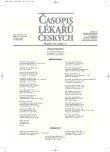Capsule Endoscopy – The Past, Presence, and Future
Kapslová endoskopie – minulost, přítomnost a budoucnost
Bezdrátová kapslová endoskopie je bezpečná a neinvazivní metoda využívaná k zobrazení tenkého střeva a terminálního jícnu. Vyšetření je velmi dobře tolerováno pacientem. Pro možnost detailního ohodnocení sliznice tenkého střeva má v současnosti kapslová endoskopie vyšší diagnostickou výtěžnost než ostatní dostupné modality. Zvláště užitečná je tato metoda při vyšetřování zjevného a okultního krvácení, celiakie a Crohnovských lézí. V jícnu je kapslová endoskopie určena především k dlouhodobému sledování nemocných s Barrettovým jícnem, cena vyšetření je však výrazně vyšší než gastroskopie. Uvíznutí kapsle je nejzávažnější, ale prakticky jedinou komplikací vyšetření vyžadující často elektivní chirurgické řešení. Budoucnost kapslové endoskopie je závislá na rozvoji technologie.
Klíčová slova:
kapslová endoskopie, krvácení do gastrointestinálního traktu, Crohnova, choroba, celiakie, vyšetření tenkého střeva, Barrettův jícen.
Authors:
P. Drastich
Authors‘ workplace:
Klinika hepatogastroenterologie IKEM, Praha
Published in:
Čas. Lék. čes. 2006; 145: 432-436
Category:
Review Article
Overview
Wireless capsule endoscopy is a safe non-invasive method for the examination of the small intestine and terminal oesophagus. Examination is well tolerated by most of the patients. Due to the possibility to assess mucosa of the small intestine in details, capsule endoscopy has the diagnostical yield higher than other available methods. It is effective namely for study of obscure bleeding, celiac disease and Crohn’s disease. Capsule endoscopy is aimed at the longterm follow up of patients with Barrett’s oesophagus, however, the costs are higher than using gastroscopy. Capsule retention represents the most serious and practically the only complication of the examination which frequently requires surgical treatment. The future of capsule endoscopy depends on the next development of the technology.
Key words:
capsule endoscopy, bleeding into the gastrointestinal system, Crohn’s disease, celiac disease, small intestine examination, Barrett’s oesophagus.
Labels
Addictology Allergology and clinical immunology Angiology Audiology Clinical biochemistry Dermatology & STDs Paediatric gastroenterology Paediatric surgery Paediatric cardiology Paediatric neurology Paediatric ENT Paediatric psychiatry Paediatric rheumatology Diabetology Pharmacy Vascular surgery Pain management Dental HygienistArticle was published in
Journal of Czech Physicians

- Advances in the Treatment of Myasthenia Gravis on the Horizon
- Spasmolytic Effect of Metamizole
- Metamizole at a Glance and in Practice – Effective Non-Opioid Analgesic for All Ages
- What Effect Can Be Expected from Limosilactobacillus reuteri in Mucositis and Peri-Implantitis?
- Metamizole vs. Tramadol in Postoperative Analgesia
Most read in this issue
- Faecal Elastase I. Assessment – Its Use in Diagnosis of Chronic Pancreatitis
- Injury of the Scapholunate Interosseal Ligament – Scapholunate Dissociation
- Hyperamylasemia, Laboratory and Clinical Aspects
- Capsule Endoscopy – The Past, Presence, and Future
